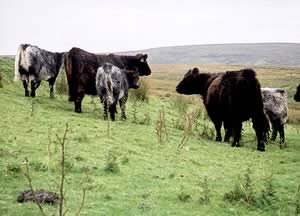 |
|||||||||
|
|||||||||||||||||||
|
|
Graziers Key to Maintaining Our Vast Areas of Common Land 2009-07-17 The future of landscape quality and public benefits from England’s thousands of acres of common land is at risk unless the graziers who manage them continue to receive agricultural and environmental support.
These are among the findings published in a 256 page study produced by the Pastoral Commoning Partnership, which included a number of practising commoners, under a contract from Natural England held by Carlisle based land agency H&H Bowe. The report, Trends in Pastoral Commoning, covers those commons that are grazed with livestock, examines examples of the diversity of one million acres of common land throughout England, from coastal and lowland commons to the vast hill and upland area including the Lake District and the Pennines in the north and Exmoor and Dartmoor in the south west, 30 per cent of which is in Cumbria. The research combines data from desk studies with new field data gathered from 18 commons across England and from 20 national and regional stakeholders with an interest in common land. The field data reviews changes over a twenty year period until 2007 and anticipated changes over the following twenty years to 2027. H&H Bowe’s Julia Aglionby, a specialist in commons and their management, and one of the authors of the report concludes that Government backing is essential through agricultural support and environmental schemes for an active community of commoners. “The process of pastoral communing is like a tree with the commoner as the trunk,” she says. “To maintain the commoner, a range of nutrients are required, a profitable livestock business with acceptable stock prices being the essential input. “It is also recognised that Government support is essential through agricultural support and environmental schemes.” The project director, Andrew Humphries MBE, says that despite evidence outlined in the report of improved agricultural efficiency in recent decades and the potential for adding value, primary production is contributing to farm incomes on a declining scale. “The research has identified support to add value to the primary produce which is an important aspect of sustaining the motivation of graziers. “However, the decoupling of support from grazing stock and the issues surrounding the Single Farm Payment has drawn the fragility of primary production into sharp focus. “Primary production is now complemented by a range of ‘public goods’ which make commons of national significance for flora, fauna, access and cultural landscape which are strongly ‘externally focussed’. “The challenge to Natural England and Defra to link market and public goods into a coherent and sustainable system demands timely and deep deliberation.” Mr Humphries predicts that this demand for ‘public goods’ coupled with the influence of global climatic changes is likely to change pastoral commons at a revolutionary pace and this adjustment process could be enhanced by collaboration and mutual understanding. The historical importance of commons is highlighted by Port Meadow in Oxford which was mentioned in the Domesday Book in 1086. Complex sheep identification systems on many commons are thought to have originated in Viking times. Their environmental significance is made in a current proposal to seek World Heritage Status for the Lake District as an exceptional landscape and place further links to communal grazings. The steering group makes particular mention of the “statesmen’s landscape‟ and the assessment of outstanding significance refers specifically to “Commons: valued for their visual openness‟ and to the history of communal land management as unenclosed grazing. Prominent among those who recognised the “public goods” linked to commons were the literary figures of the Lake District. Wordsworth successfully led the opposition to enclose Grasmere common by the agent of Lady le Fleming, leaving the common in its state of semi natural beauty and the commoners with their rights of commonage and goosage. Canon Hardwicke Rawnsley the prime mover in the establishment of the National Trust and profoundly influenced by Ruskin, wrote with deep commitment and understanding of commoning in his description of being “on Hellvellyn with the shepherds” showing genuine understanding of the special cultural nature of communal grazing and its effect on commoners.
|
||||||||||||||||||

|
|
||||||||||||||||||
| home | agri-services | pedigree
pen | news | dairy | beef | machinery quota | property | organisations | site map |
|||||||||||||||||||


